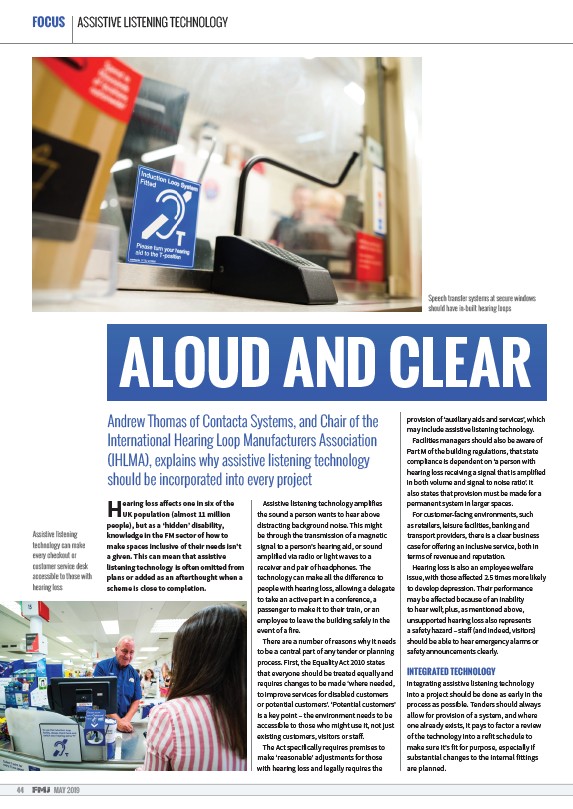
FOCUS ASSISTIVE LISTENING TECHNOLOGY
44 MAY 2019
Speech transfer systems at secure windows
should have in-built hearing loops
ALOUD AND CLEAR
Andrew Thomas of Contacta Systems, and Chair of the
International Hearing Loop Manufacturers Association
(IHLMA), explains why assistive listening technology
should be incorporated into every project
Hearing loss a ects one in six of the
UK population (almost 11 million
people), but as a ‘hidden’ disability,
knowledge in the FM sector of how to
make spaces inclusive of their needs isn’t
a given. This can mean that assistive
listening technology is o en omitted from
plans or added as an a erthought when a
scheme is close to completion.
Assistive listening technology amplifies
the sound a person wants to hear above
distracting background noise. This might
be through the transmission of a magnetic
signal to a person’s hearing aid, or sound
amplified via radio or light waves to a
receiver and pair of headphones. The
technology can make all the di erence to
people with hearing loss, allowing a delegate
to take an active part in a conference, a
passenger to make it to their train, or an
employee to leave the building safely in the
event of a fire.
There are a number of reasons why it needs
to be a central part of any tender or planning
process. First, the Equality Act 2010 states
that everyone should be treated equally and
requires changes to be made ‘where needed,
to improve services for disabled customers
or potential customers’. ‘Potential customers’
is a key point – the environment needs to be
accessible to those who might use it, not just
existing customers, visitors or sta .
The Act specifically requires premises to
make ‘reasonable’ adjustments for those
with hearing loss and legally requires the
provision of ‘auxiliary aids and services’, which
may include assistive listening technology.
Facilities managers should also be aware of
Part M of the building regulations, that state
compliance is dependent on ‘a person with
hearing loss receiving a signal that is amplified
in both volume and signal to noise ratio’. It
also states that provision must be made for a
permanent system in larger spaces.
For customer-facing environments, such
as retailers, leisure facilities, banking and
transport providers, there is a clear business
case for o ering an inclusive service, both in
terms of revenue and reputation.
Hearing loss is also an employee welfare
issue, with those a ected 2.5 times more likely
to develop depression. Their performance
may be a ected because of an inability
to hear well; plus, as mentioned above,
unsupported hearing loss also represents
a safety hazard – sta (and indeed, visitors)
should be able to hear emergency alarms or
safety announcements clearly.
INTEGRATED TECHNOLOGY
Integrating assistive listening technology
into a project should be done as early in the
process as possible. Tenders should always
allow for provision of a system, and where
one already exists, it pays to factor a review
of the technology into a refit schedule to
make sure it’s fit for purpose, especially if
substantial changes to the internal fittings
are planned.
Assistive listening
technology can make
every checkout or
customer service desk
accessible to those with
hearing loss